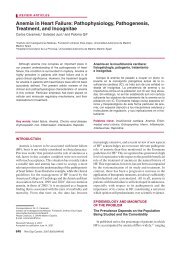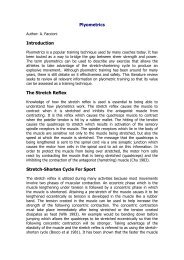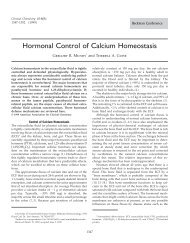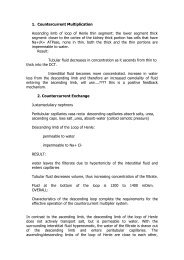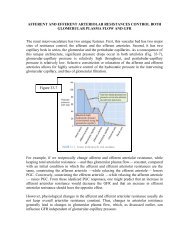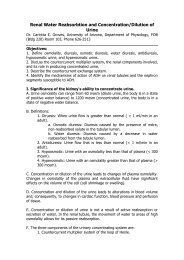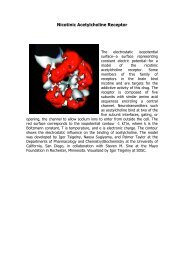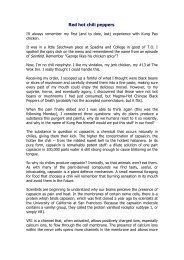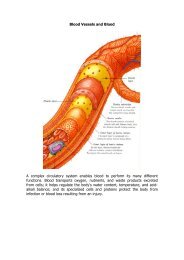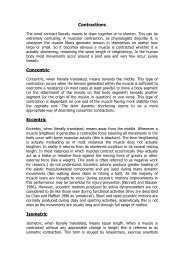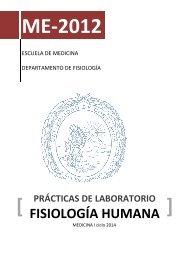Role of Gastrointestinal Hormones in the Proliferation of Normal and ...
Role of Gastrointestinal Hormones in the Proliferation of Normal and ...
Role of Gastrointestinal Hormones in the Proliferation of Normal and ...
Create successful ePaper yourself
Turn your PDF publications into a flip-book with our unique Google optimized e-Paper software.
Thomas et al. • <strong>Gastro<strong>in</strong>test<strong>in</strong>al</strong> <strong>Hormones</strong> <strong>and</strong> <strong>Proliferation</strong> Endocr<strong>in</strong>e Reviews, October 2003, 24(5):571–599 581proglucagon gene). Mice with all three xenograft types demonstratedan <strong>in</strong>crease <strong>in</strong> small bowel weight, crypt-villusheight, <strong>and</strong> percentage <strong>of</strong> BrdU-positive cells; glicent<strong>in</strong> (43.75g) adm<strong>in</strong>istered twice daily for 10 d produced modest <strong>in</strong>creases<strong>in</strong> total small bowel weight. Nei<strong>the</strong>r GLP-1 nor IP-1had an effect on <strong>the</strong> gut mucosa, whereas GLP-2 produceda 50% <strong>in</strong>crease <strong>in</strong> small bowel weight. Fur<strong>the</strong>rmore, onlyGLP-2 produced a significant <strong>in</strong>crease <strong>in</strong> mucosal thickness,with <strong>the</strong> <strong>in</strong>crease attributable to <strong>in</strong>creased villus height (149).Similarly, Ghatei et al. (151) demonstrated prom<strong>in</strong>ent trophiceffects <strong>of</strong> GLP-2 <strong>in</strong> Wistar rats. Us<strong>in</strong>g vary<strong>in</strong>g doses <strong>of</strong> enteroglucagon,GLP-1, oxyntomodul<strong>in</strong>, <strong>and</strong> GLP-2, onlyGLP-2 produced a dose-dependent <strong>in</strong>crease <strong>in</strong> <strong>the</strong> weight <strong>of</strong>stomach, small <strong>in</strong>test<strong>in</strong>e, <strong>and</strong> colon <strong>of</strong> parenterally fed rats.Therefore, <strong>the</strong>se studies confirmed that, <strong>of</strong> <strong>the</strong> PGDPs, GLP-2was <strong>the</strong> major mediator <strong>of</strong> <strong>in</strong>test<strong>in</strong>al epi<strong>the</strong>lial proliferation.Litvak et al. (152, 153) demonstrated that GLP-2 (1.75g/kg twice a day) significantly <strong>in</strong>creased <strong>the</strong> weight <strong>of</strong>jejunum, ileum, <strong>and</strong> colon <strong>of</strong> athymic nude mice comparedwith both control mice <strong>and</strong> mice treated with NT (600 g/kgthree times a day). These studies confirmed <strong>the</strong> previousf<strong>in</strong>d<strong>in</strong>gs <strong>of</strong> a trophic effect for GLP-2 <strong>and</strong> demonstrated that<strong>the</strong> proliferative effects were equal to or greater than those<strong>of</strong> NT. In ano<strong>the</strong>r study, GLP-2-produc<strong>in</strong>g tumor cells (STC-1cells) were implanted <strong>in</strong> athymic mice <strong>and</strong> <strong>the</strong>n r<strong>and</strong>omizedto receive ei<strong>the</strong>r NT or sal<strong>in</strong>e (152, 153). The mice treated withNT <strong>and</strong> GLP-2 (from STC-1) displayed significant <strong>in</strong>creases<strong>in</strong> jejunal <strong>and</strong> ileal weight <strong>and</strong> prote<strong>in</strong> content over ei<strong>the</strong>r NTor GLP-2 alone. The adm<strong>in</strong>istration <strong>of</strong> NT appeared to enhance<strong>the</strong> enterotrophic effects <strong>of</strong> GLP-2, suggest<strong>in</strong>g that <strong>the</strong>comb<strong>in</strong>ation may be useful to enhance <strong>in</strong>test<strong>in</strong>al growth <strong>in</strong>patients with short bowel syndrome.In addition to <strong>the</strong> effects <strong>of</strong> GLP-2 on normal mucosa, <strong>the</strong>effects <strong>of</strong> this agent dur<strong>in</strong>g periods <strong>of</strong> gut <strong>in</strong>jury or atrophyhave also been assessed. Mice treated with <strong>the</strong> nonsteroidalagent <strong>in</strong>domethac<strong>in</strong> develop small bowel enteritis associatedwith significant mortality at 48–72 h after adm<strong>in</strong>istration;treatment with human [Gly 2 ]GLP-2 before, dur<strong>in</strong>g, or after<strong>in</strong>domethac<strong>in</strong> adm<strong>in</strong>istration resulted <strong>in</strong> reduced mortality<strong>and</strong> decreased mucosal <strong>in</strong>jury (154). The protective effectswere attributed to significantly <strong>in</strong>creased crypt cell proliferation<strong>and</strong> decreased crypt compartment apoptosis. Theeffect <strong>of</strong> GLP-2 on chemo<strong>the</strong>rapy-<strong>in</strong>duced <strong>in</strong>test<strong>in</strong>al mucositishas also been assessed. Pretreatment <strong>of</strong> mice with human[Gly 2 ]GLP-2 before adm<strong>in</strong>istration <strong>of</strong> <strong>the</strong> topoisomerase <strong>in</strong>hibitorir<strong>in</strong>otecan resulted <strong>in</strong> reduced bacterial <strong>in</strong>fection, <strong>in</strong>test<strong>in</strong>aldamage, <strong>and</strong> mortality (155). Histological <strong>and</strong> biochemicalanalyses revealed significant reductions <strong>in</strong> cryptcompartment apoptosis <strong>and</strong> reduced caspase-8 activation.Consistent with <strong>the</strong>se reports, Tavakkolizadeh et al. (156)noted decreased <strong>in</strong>test<strong>in</strong>al damage <strong>in</strong> rats given GLP-2 <strong>in</strong>comb<strong>in</strong>ation with <strong>the</strong> chemo<strong>the</strong>rapeutic agent 5-fluorouracil.F<strong>in</strong>ally, repeated cyclical adm<strong>in</strong>istration <strong>of</strong> both human[Gly 2 ]GLP-2 <strong>and</strong> ir<strong>in</strong>otecan resulted <strong>in</strong> decreased mortality<strong>in</strong> groups <strong>of</strong> BALB/C mice implanted with sc CT-26 coloncarc<strong>in</strong>omas. These data suggest that GLP-2 may have <strong>the</strong>rapeuticadvantages for cancer patients by support<strong>in</strong>g bowel<strong>in</strong>tegrity without dim<strong>in</strong>ish<strong>in</strong>g <strong>the</strong> effectiveness <strong>of</strong> <strong>the</strong>chemo<strong>the</strong>rapy.2. Colon. Although <strong>the</strong> small bowel is significantly moresensitive to <strong>the</strong> effects <strong>of</strong> GLP-2, studies have shown thatGLP-2 <strong>and</strong> GLP-2 analogs can stimulate <strong>the</strong> growth <strong>of</strong> colonicmucosa. As previously noted, Litvak et al. (152) demonstrateda trophic effect <strong>of</strong> GLP-2 on <strong>the</strong> colonic mucosa <strong>of</strong>athymic nude mice. Drucker et al. (157) demonstrated an<strong>in</strong>crease <strong>in</strong> colonic growth us<strong>in</strong>g dipeptidyl peptidase IVresistantGLP-2 analog, human [Gly 2 ]GLP-2 <strong>in</strong> CD1 mice.Fur<strong>the</strong>rmore, <strong>the</strong> comb<strong>in</strong>ation <strong>of</strong> this agent with IGF-I, GH,or long [Arg3]IGF-I produced a greater <strong>in</strong>crease <strong>in</strong> largebowel mass than mice treated with [Gly 2 ]GLP-2 alone.Treatment with GLP-2 has also been shown to reducecolonic mucosal <strong>in</strong>jury, similar to <strong>the</strong> f<strong>in</strong>d<strong>in</strong>gs <strong>in</strong> <strong>the</strong> smallbowel (51). In a dextran sulfate-<strong>in</strong>duced colitis model, concomitantadm<strong>in</strong>istration <strong>of</strong> sc human [Gly 2 ]GLP-2 <strong>and</strong> oraldextran sulfate for 10 d resulted <strong>in</strong> markedly reduced colonicdamage <strong>and</strong> decreased weight loss <strong>in</strong> CD1 <strong>and</strong> BALB/Cmice. Treatment with [Gly 2 ]GLP-2 preserved colonic length,decreased <strong>in</strong>test<strong>in</strong>al histological damage, reduced IL-1 expression,<strong>and</strong> <strong>in</strong>creased crypt cell proliferation.G. Somatostat<strong>in</strong>Somatostat<strong>in</strong> has predom<strong>in</strong>antly <strong>in</strong>hibitory effects, whichhave been used to advantage <strong>in</strong> certa<strong>in</strong> cl<strong>in</strong>ical scenarios.Somatostat<strong>in</strong> <strong>in</strong>hibits pancreatic <strong>and</strong> GI secretion <strong>and</strong> GImotility <strong>and</strong> <strong>in</strong>hibits <strong>the</strong> release <strong>of</strong> GH <strong>and</strong> all known GIhormones (3). The active peptide analog <strong>of</strong> somatostat<strong>in</strong>(octreotide) has been effectively used as an agent to amelioratesymptoms associated with endocr<strong>in</strong>e-overproduc<strong>in</strong>gtumors, pancreatic fistulas, <strong>and</strong> enterocutaneous fistulas(158, 159). In experimental studies, somatostat<strong>in</strong> has alsobeen shown to <strong>in</strong>hibit <strong>the</strong> growth <strong>of</strong> <strong>the</strong> GI mucosa <strong>and</strong>normal pancreas (158, 159). These effects may be throughei<strong>the</strong>r an <strong>in</strong>direct mechanism such as <strong>in</strong>hibition <strong>of</strong> o<strong>the</strong>rtrophic hormones or a direct effect through <strong>in</strong>teraction with<strong>the</strong> somatostat<strong>in</strong> receptor subtype 2 (160, 161). This somatostat<strong>in</strong>receptor subtype associates <strong>and</strong> stimulates tyros<strong>in</strong>ephosphatase src homology 2-conta<strong>in</strong><strong>in</strong>g tryos<strong>in</strong>e phosphatase1 activity, which <strong>in</strong> turn arrests cells <strong>in</strong> <strong>the</strong> G o /G 1 phase<strong>of</strong> <strong>the</strong> cell cycle associated with up-regulation <strong>of</strong> <strong>the</strong>cycl<strong>in</strong>-dependent k<strong>in</strong>ase <strong>in</strong>hibitor p27 kip1 <strong>and</strong> an <strong>in</strong>crease <strong>in</strong>hypophosphorylated ret<strong>in</strong>oblastoma prote<strong>in</strong> levels (160,161). Although <strong>the</strong> major portion <strong>of</strong> this review has focusedon <strong>the</strong> stimulatory effects <strong>of</strong> various GI hormones, it is importantto discuss <strong>the</strong> <strong>in</strong>hibition <strong>of</strong> growth us<strong>in</strong>g somatostat<strong>in</strong><strong>and</strong> its analogs.1. Stomach. The effects <strong>of</strong> somatostat<strong>in</strong> on gastric mucosalgrowth have been assessed. Treatment <strong>of</strong> Wistar rats withsomatostat<strong>in</strong> (50 g/kgh) reduced nuclear uptake <strong>of</strong>[ 3 H]thymid<strong>in</strong>e <strong>and</strong> cell division <strong>in</strong> both fundic <strong>and</strong> antralprogenitor cells (162). Fur<strong>the</strong>rmore, <strong>the</strong> comb<strong>in</strong>ation <strong>of</strong> somatostat<strong>in</strong><strong>and</strong> gastr<strong>in</strong> reduced gastr<strong>in</strong>-stimulated DNA syn<strong>the</strong>sis<strong>in</strong> <strong>the</strong> gastric mucosa. In contrast, <strong>in</strong> <strong>the</strong> duodenum<strong>and</strong> jejunum, <strong>the</strong> effects <strong>of</strong> somatostat<strong>in</strong> were less consistent,with nocturnal somatostat<strong>in</strong> produc<strong>in</strong>g slight decreases <strong>in</strong>DNA syn<strong>the</strong>sis. These f<strong>in</strong>d<strong>in</strong>gs suggested that somatostat<strong>in</strong>could <strong>in</strong>hibit cell proliferation <strong>in</strong> <strong>the</strong> mucosa <strong>of</strong> <strong>the</strong> normalGI tract <strong>and</strong>, fur<strong>the</strong>rmore, could antagonize <strong>the</strong> trophic ac-Downloaded from edrv.endojournals.org by on July 16, 2007



